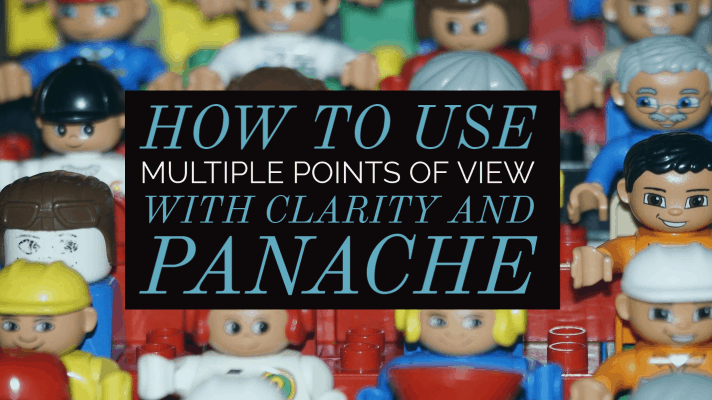These days a lot of commercial fiction is written in third-person close point of view (POV)—meaning that a novel comes from a single perspective but is told to the reader in third-person POV. There is also a current trend of YA novels written in first person POV, in which readers get truly intimate with the narrator’s thoughts.
First person: I didn’t know what Clyde meant, but I smiled anyway.
Omniscient: Bonnie didn’t know what Clyde meant. He was pleased to see her smile.
Third person: Despite a look of confusion on her face, Bonnie smiled.
Third person close: Bonnie wasn’t sure what Clyde meant, but she smiled anyway.
Novelists must make conscious choices of how to tell their story.
There are a number of reasons why the author of a complex, multifacted novel might want to include contrasting perspectives. Alternating viewpoints between characters of different ages or from different cultures can provide nuance. Or switching POVs might amp up the tension or the suspense in certain scenes. An author of a series might include more perspectives to keep a franchise fresh. Whatever the motive, featuring more than one POV can add desirable complexity to a reader’s interpretation of the story.
One possibility for authors is to use a know-it-all omniscient POV—a thorny option that’s difficult to pull off. More commonly, writers facing this challenge (from Toni Morrison to George R.R. Martin) have opted for alternating POVs.
Like all literary strategies, alternating POVs must be done with care. Within the overall book, switches from one to POV to another should follow a pattern to lessen reader confusion. If that pattern is broken, it should be done for an attention-getting narrative reason.
Too many heads
While it may prove difficult for a writer to transmit important plot information without jumping into another character’s head, the derisive charge of “head-hopping” signals too many POVs in a single novel.
Brief jumps from POV to POV solely to achieve plot utility are an amateur move. Continually hopping from one POV to another will cause readers’ heads to spin.
For example, it may build suspense for a novelist to cut to the viewpoint of a sniffing building super so readers become aware that there’s a leaky gas pipe about to explode. But at this point, an author must make crafty calculations. Is there another way to signal this dangerous situation without introducing the intrusive perspective of a minor character?
For the reader to enter a character’s head, the character should do more than just keep the plot moving.
Beyond a narrative functionality, a character with a POV must be worthy of our notice. This aforementioned super might not merit his own POV section.
Agent Paula Munier urges novelists to limit themselves to five POVs per novel.
That’s not to say you need five POVs—just that this is the max.
Distinct viewpoints
Novelists who decide to include more than one POV avoid confusing omniscience by clearly separating out each POV. One POV per chapter is the norm, though a single chapter may also include discrete sections with alternating POVs; a line break between them signals the change.
A reader must never have any doubts about whose head they are in. Differing POVs should be separated by tone and personality. Each included voice must be unique. After a POV switch, clarify the viewpoint as soon as possible by including a name or another clue.
Every passage should propel the book’s plot forward
After an author changes from one POV to another, they should not bore readers or risk causing them to skim by repeating information they have previously learned in the book. Instead, you might write something like this: “As the plane circled above, Steve quickly summarized for Donald what had happened earlier on the yacht.”
I … I … I …
When there are numerous characters in different sections using the first person “I,” it may be extra tough for readers to keep the characters straight. Writers exponentially increase the challenge of creating a convincing and memorable first-person voice. Here again, distinct voices in alternating POVs are crucial.
While the text should plainly signal any POV change, labeling the sections when the switch is made will also help keep readers on track.
First person/Third person
While the practice is often discouraged, ambitious writers might want to switch it up even more by taking on the challenge of alternating viewpoints between a first person POV and a third person POV. As above, this choice should be made for specific narrative reasons.
It adds complexity. These differing viewpoints offer readers dissimilar levels of intimacy with the characters. For example, readers might see and interpret the world through the eyes of a first-person POV; then they jump to a third-person POV character, observing a character’s actions without fully understanding their motivations. That tension between POVs might be what is driving the plot.
Intimacy issues
Cutting away from the POV of a single main character may lessen the reader’s connection to that central character. Writers must decide if it’s worth it. Their book could become less like a delicious single apple and more like a Waldorf Salad—both appealing options offering different experiences.
Do you use alternating POVs in your fiction writing? Share with us why or why not on Facebook.





